Upper vs Lower Antelope Canyon: Which is Better? Differences, Tours and More
Are you hesitating between Upper vs Lower Antelope Canyon? We’ve got you covered! Whether you’re wondering about what the most picturesque canyon is or where to see the famous light beams, you’ll find all your answers in this post!
We’ve visited both Upper and Lower Antelope Canyons during peak season while road tripping across the United States of America. Road tripping the USA is one of the most romantic road trips you can have with a partner! During this road trip, we traveled the West Coast but also across Utah and Arizona and Antelope Canyon was one of our favorite stops. So we are excited to share our personal experience but also our tips and everything you need to know to best choose between the two if you have to.
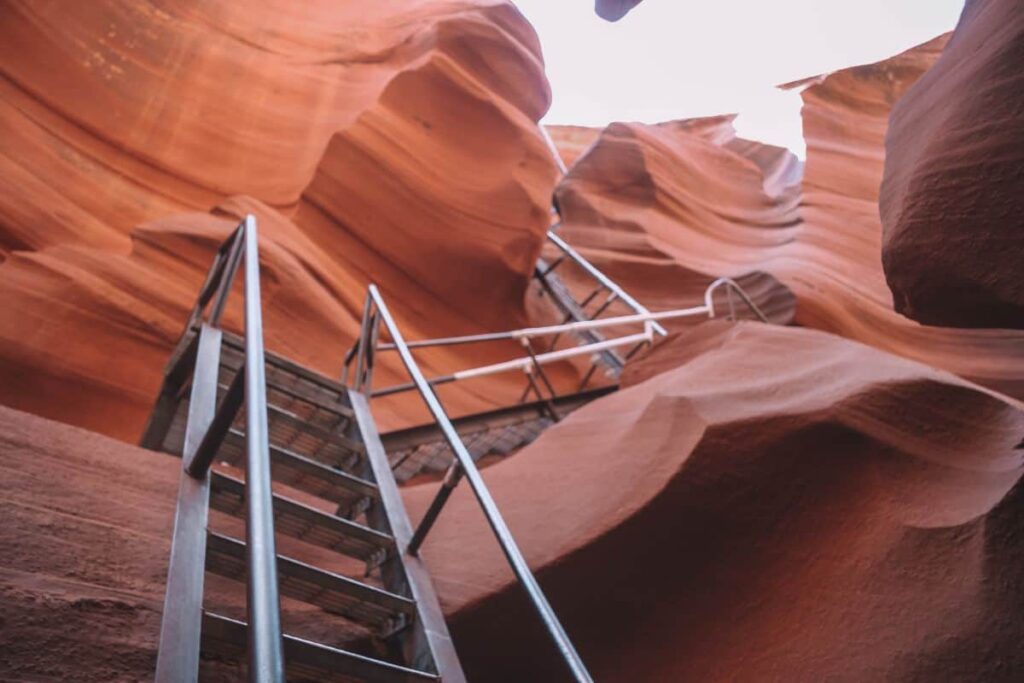
Upper vs Lower Antelope Canyon: Our Experience and Preference
During our visit, we had the opportunity to explore both Upper and Lower Antelope Canyon on the same day. Our first visit was to the Upper Canyon at 2pm, followed by the Lower Canyon at 4 pm. While we enjoyed both, we found ourselves leaning towards a preference for the Upper Canyon.
Our visit took place in August when the weather was hot and dry. The Upper Canyon tour was initially scheduled for one hour but ended up lasting an hour and a half. Our guide, Charles, was incredibly nice and helpful. He provided us with photography tips to capture the canyon’s true colors using our phones.
The Upper Canyon experience began with a thrilling 20-30 minute truck ride on a dirt track, taking us to the canyon’s entrance. It was a fun and hot ride. Inside the canyon, we walked through stunning sandstone formations, with openings in the ceilings that allowed streams of sunlight to illuminate the canyon’s beauty.
Later in the afternoon, we embarked on the Lower Antelope Canyon tour. Due to the extended duration of our Upper Canyon visit, we realized we would be running late for the Lower Canyon tour. We promptly called and explained our situation, and they kindly rescheduled us for a later tour. Our guide for the Lower Canyon was Tyler.
For the Lower Antelope Canyon, we joined the tour at 4 pm. The Lower Canyon started with a walk across a flat stone field, leading to a descent down several stairs. It had a lighter ambiance compared to the Upper Canyon, with vibrant colors but in a less impressive way. However, it still left us a unique experience.
In summary, we preferred the Upper Antelope Canyon for its stunning formations and vibrant colors. However, we highly recommend exploring both Upper and Lower if you have the chance. Each section has its own distinct beauty and provides an incredible journey through the captivating wonders of Antelope Canyon.
Upper vs Lower Antelope Canyon: Pros and Cons summary
| pros and cons | Upper Antelope Canyon | Lower Antelope Canyon |
|---|---|---|
| Accessibility | Requires 4×4 ride to the entrance | Walkable entrance |
| Stairs | No stairs | Steep stairs |
| Lighting | Less natural light, but stunning light beams | More natural light, better for photography |
| Crowd Levels | More crowded | Generally less crowded |
| Adventure Level | Less adventurous | More adventurous |
| Photography | Sand falls and dramatic formations | Better lighting for photography |
| Overall Beauty | Impressive with tall walls and unique features | Beautiful with twisting formations |
Which is better Upper or Lower Antelope Canyon
Which Antelope Canyon is Better: Upper or Lower? When it comes to choosing between Upper and Lower Antelope Canyon, it depends on what you’re looking for in your experience. Let’s explore the highlights of each to help you make an informed decision.
Upper Antelope Canyon: Easy Accessibility and Colorful Canyon with Light Beams
If you prefer easy accessibility and are eager to witness the vibrant colors and stunning light beams, Upper Antelope Canyon is the way to go. This section of the canyon offers a more accessible and tourist-friendly experience. The canyon’s iconic light beams that shine through the narrow openings above create a mesmerizing sight that many come to see.
Lower Antelope Canyon: More Adventure and Insight into Canyons with Fewer Crowds
For those seeking a more adventurous experience and a chance to delve deeper into the canyons, Lower Antelope Canyon is the better option in our experience. This section provides a unique opportunity to explore the intricacies of the canyon’s rock formations and gain insights into its geological history. With fewer crowds compared to the Upper Canyon, you can enjoy a more intimate and immersive experience.
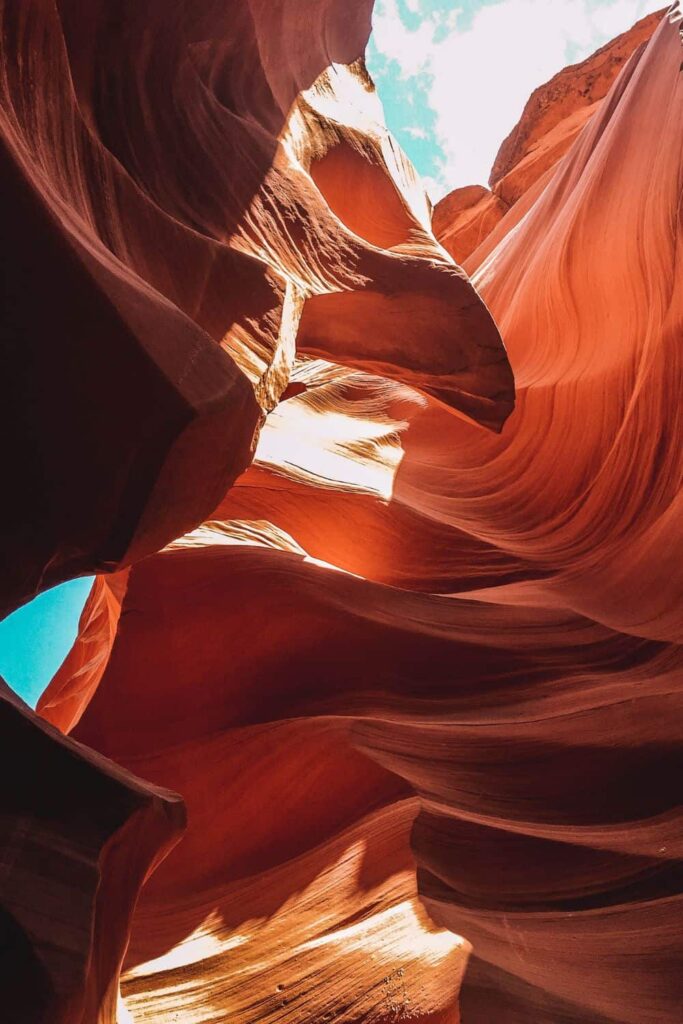

Is Lower Upper Antelope Canyon fun for couples?
In our opinion, yes!
Visiting Upper Lower Antelope Canyon is a wonderful experience for couples, offering breathtaking beauty and a romantic setting. The stunning rock formations, captivating light beams, and vibrant colors create a magical ambiance that is perfect for creating lasting memories together.
Exploring the canyons hand in hand allows you to appreciate the natural wonders and enjoy a sense of adventure as you navigate through the narrow passageways. The opportunity to capture stunning couple photos against the backdrop of the canyon’s unique features adds an extra touch of romance.
Whether you’re nature enthusiasts, photography lovers, or simply seeking a romantic getaway, Antelope Canyon offers an unforgettable experience for couples to cherish.
What’s the Difference Between Upper and Lower Antelope Canyon?
When it comes to comparing Upper and Lower Antelope Canyon, there are several notable differences that make each section unique. Let’s delve into the distinctions to help you understand their individual characteristics.
Upper vs Lower Antelope Canyon Size and Shape
The biggest difference lies in the size and shape of the canyons themselves. Upper Antelope Canyon has a wider bottom and narrower top, forming an A shape. On the other hand, Lower Antelope Canyon is smaller at the bottom and larger at the top, creating a V shape.
Upper and Lower Antelope Canyon Accessibility and Lighting
Upper Antelope Canyon is generally easier to walk through, but it can be darker due to the narrower openings that restrict the natural light. In contrast, Lower Antelope Canyon requires navigating steep stairs to access, but it offers a brighter ambiance with more sunlight penetrating the wider openings. Lower Antelope Canyon also is deeper compared to the Upper Canyon.
Transportation and Access
To reach the entrance of Upper Antelope Canyon, you’ll embark on a 20-30 minute truck ride on a dirt track. In contrast, reaching Lower Antelope Canyon’s entrance only requires a short walk though you’ll have to go down steep stairs to reach the bottom of the canyon. The stairs are quite steep and can be hard for anyone with a fear of height. I (Marie) have a fear of height and it was challenging to go down. It took me a few minutes before I embarked on those stairs! Because they made them as discreet as possible, the spaces between the steps are actually open which is one of the things that triggered my fear! But the guide was patient and I was able to take my time to go down.
Additionally, it’s worth noting that while kayaking is permitted in Lower Antelope Canyon, it is not allowed in the Upper Canyon.
Upper and Lower Antelope Canyon Naming and Conservation
Both sections of the canyon are named after pronghorn antelopes that used to graze in the area. In 1997, the Navajo Tribe designated the canyons as the Navajo Tribal Park, ensuring their preservation and protection.
Upper and Lower Antelope Canyon Flash Flooding
Lastly, it’s important to be aware that both Upper and Lower Antelope Canyons are susceptible to flash flooding. During summer especially, there is a risk of sudden and powerful floods within the canyons even when the rain is falling miles away. It is crucial to stay informed about weather conditions and follow any safety instructions or closures issued by the authorities.


Which is Prettier Upper or Lower Antelope Canyon?
When it comes to the beauty of Upper and Lower Antelope Canyon, we think both sections are undeniably stunning in their own right.
Famous Light Beams at the canyon Upper Antelope
Upper Antelope Canyon gained recognition for its iconic light beams, captured in Peter Lik’s famous photograph “The Ghost” that sold for over $6 million dollars. These mesmerizing light beams are a spectacle to behold and attract thousands of visitors each day during peak season.
Similarity in Beauty
In our experience, both Upper and Lower Antelope Canyon offered equally breathtaking displays of vibrant colors, captivating light, and unique rock formations. We found them to be remarkably similar in terms of their beauty, making it difficult to choose one as prettier than the other. We genuinely loved both canyons and appreciated their individual charm.
No Fear of Missing Out (FOMO)
If you’re concerned about missing out on a spectacular experience by choosing one over the other, rest assured that both canyons are equally stunning. Exploring either Upper or Lower Antelope Canyon will leave you in awe of the impressive slot canyons and their natural wonders.
Personal Preferences and Expectations
Opinions on which canyon is prettier can vary depending on personal preferences and expectations. For instance, if you’re a photographer seeking specific shots, your expectations may differ from those seeking an adventurous experience with their partner. Each individual’s perspective may shape their opinion of which canyon resonates with them the most. We loved each canyon for different reasons!
No Disappointment
Ultimately, we were not disappointed with either Upper or Lower Antelope Canyon. Both canyons offered breathtaking beauty and unique experiences. Whether you choose to visit one or both, you can expect to be immersed in the enchanting beauty of these natural wonders.
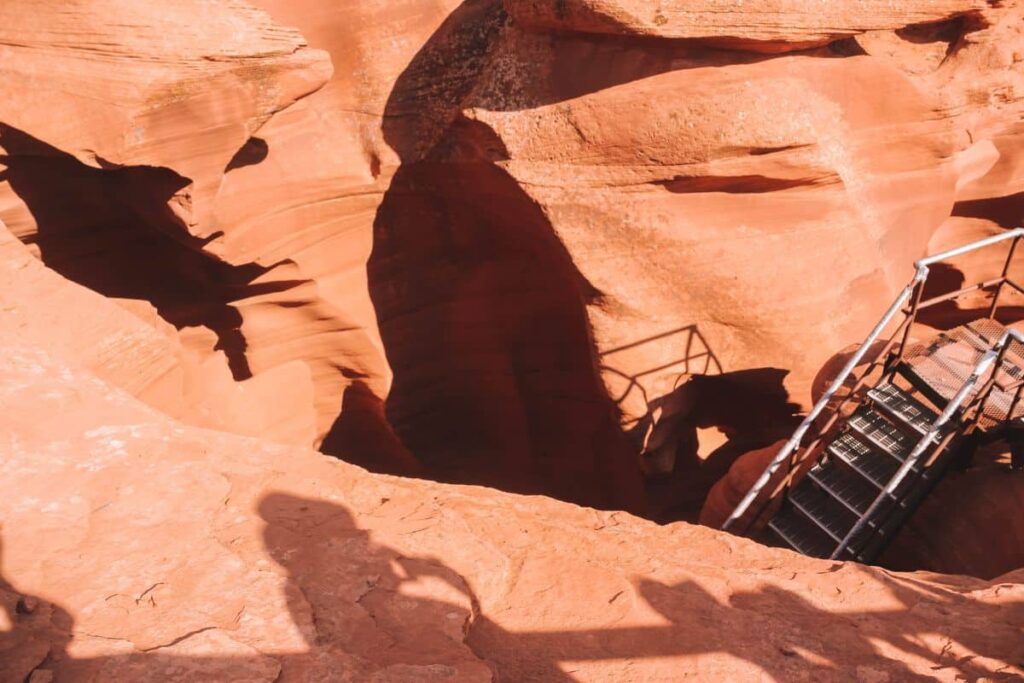
Upper versus Lower Antelope Canyon: Pros and Cons of Upper Antelope Canyon
What is Upper Antelope Canyon?
Upper Antelope Canyon is the more popular and widely known of the two canyons. It is a slot canyon, formed by the erosion caused by water rushing through the rock over time. In Navajo, it is known as “Tsé bighánílíní,” meaning “the place where water runs through rocks.” Note that it is not a canyon national park.
Unique Features and Photogenic Qualities: The entrance and the entire length of Upper Antelope Canyon are at ground level, making it easily accessible. It is renowned for its striking light beams, tall canyon walls, distinct shape, and mesmerizing falling sands. Many consider it the most photogenic among the three Antelope Canyons.
A-Shaped Canyon and Spaciousness: Upper Antelope Canyon is shaped like an “A,” narrower at the top and wider at the bottom. This design offers a more spacious feel and is less claustrophobic compared to Lower Antelope Canyon. During our visit, we were even able to go into some of the nooks of the canyon and take photos of us without having to have other people in the photos. Visitors have ample room to walk around and explore the canyon’s captivating formations.
Capturing the Light Beams: The narrow walls of the canyon allow for breathtaking light beams to penetrate during mid-day when the angle is just right. This phenomenon creates a surreal and enchanting atmosphere, adding to the canyon’s allure. Additionally, the narrow ceiling provides plenty of shade, making it cooler inside the canyon, particularly in contrast to the scorching temperatures outside.
August Visit Experience: During our visit in August, we appreciated being in Upper Antelope Canyon as the outside temperatures were extremely hot. The canyon’s cooler temperatures provided a welcome respite from the heat, allowing us to enjoy the experience comfortably.
Navajo Sandstone Formation and Length: Upper Antelope Canyon is carved out of Navajo Sandstone rock, resulting in unique and intricate formations throughout the canyon. It stretches for a length of approximately 660 feet, offering ample opportunities to witness its captivating beauty.
Pros of Upper Antelope Canyon
Known for Better Photos: Upper Antelope Canyon is renowned for being the subject of stunning photographs seen in magazines and online. The captivating light beams that occur between 10:30 am and 1 pm during the peak season make for truly extraordinary shots. Keep in mind that tours during these times are more expensive and tend to sell out quickly. However, the darker lighting conditions inside the canyon make it easier to capture impressive photos that can be enhanced during editing.
Cooler During Summer: Thanks to its distinctive A shape, Upper Antelope Canyon provides relief from the scorching summer heat. With limited sunlight filtering through, the canyon remains cooler compared to the outside temperatures. This is particularly advantageous during the peak summer months when the weather is hot and dry. Exploring the canyon offers a refreshing break from the intense heat.
Spaciousness and Comfort: The A-shaped design of Upper Antelope Canyon allows for more space, making it more comfortable for groups to move around and capture photographs. You’ll appreciate the ample room to circulate and find the perfect angles for your shots. The additional space also enhances the overall experience by reducing the feeling of crowding.
Stunning High Walls: Prepare to be awe-struck by the towering sandstone walls within Upper Antelope Canyon. These magnificent walls display vibrant shades of orange and red, creating a natural masterpiece. The breathtaking colors and intricate textures of the sandstone make it a true gem of nature.
Iconic Light Beams: Upper Antelope Canyon is famous for its iconic light beams that depend on the time of day. To maximize your chances of witnessing this phenomenon, it is advisable to book your tour during the “primetime” hours. Typically, light beams are most prominent from March to October each year. Be prepared to witness a mesmerizing display of light dancing through the narrow crevices of the canyon.
Ride in Trucks: As part of the adventure, reaching the entrance of Upper Antelope Canyon involves an exhilarating ride in the back of trucks with your group. This adds a fun and unique element to the experience. During our visit, we really appreciated the drive as it provided a refreshing breeze amidst the scorching heat, making the journey even more enjoyable.
Knowledgeable Guide: Our guide, Charles, was extremely knowledgeable and passionate about the canyon. He shared fascinating insights about its formation and guided us through the best spots to capture stunning photographs. Charles also provided valuable tips on adjusting the settings of our phones to achieve the best results.
Falling Sand: One of the unique features of Upper Antelope Canyon is the presence of falling sand. This phenomenon occurs as sand particles trickle down from the sandstone walls, creating a captivating visual effect. Capturing photos of the falling sand adds an extra element of intrigue to your visit.
Cons of Upper Antelope Canyon
More Expensive: Being the more popular option, Upper Antelope Canyon tends to come with a higher price tag compared to Lower Antelope Canyon. In recent years, prices have seen a significant increase, reflecting its growing popularity among visitors but also the introduction of mandatory prices.
Sell Out Quickly: Securing a tour at Upper Antelope Canyon can be challenging due to its high demand. While we were fortunate to book a few weeks in advance, it is not uncommon for these slot canyon tours to sell out months ahead, especially during the prime hours between 10:30 am and 1 pm. With fewer Upper Antelope Canyon tours being offered, it is advisable to book your visit as early as six months in advance to secure your desired time slot.
Darker: The darker lighting conditions inside Upper Antelope Canyon can have both advantages and disadvantages. While it presents an advantage for photography, as it is easier to brighten up photos during editing, it may appear less colorful to the naked eye. The subdued lighting creates a unique ambiance but may not showcase the vibrant colors as vividly.
More Crowded: During our visit, there were several groups touring Upper Antelope Canyon simultaneously. However, the management of the canyon ensures that the experience remains organized and not overwhelming. The wider base of the canyon and the implementation of a one-way system have helped alleviate some of the crowding concerns. Although it can still get busy at times, the overall experience remains enjoyable.

Antelope Canyon Lower vs Upper : Pros and Cons of Lower Antelope Canyon
What is Lower Antelope Canyon?
Lower Antelope Canyon is a magnificent slot canyon located approximately three miles away from Upper Antelope Canyon. It’s shape is a “V.” Unlike the upper canyon, Lower Antelope Canyon is narrow at the bottom and open at the top, allowing more natural light to illuminate the canyon floor. It used to be the less popular option, but its popularity has grown over the years.
The canyon walls in Lower Antelope Canyon are lower in height compared to Upper Antelope Canyon, but it extends deeper into the earth, reaching a depth of 120 feet. The canyon is also longer, spanning 1,335 feet, and is known as “The Corkscrew” or “Hazdistazí” in Navajo, meaning “spiral rock arches.” Previously, visitors had to climb instead of using the staircase that is now in place.
It is worth noting that on August 12, 1997, a tragic flash flood occurred in Lower Antelope Canyon, resulting in the loss of eleven lives, hence why we are insisting on the dangerousness of flash floods!
Pros of Lower Antelope Canyon
More adventurous Antelope Canyon
Exploring Lower Antelope Canyon offers a thrilling adventure with its narrow passageways, twisting walls, and ladders to climb. It feels like stepping into a different world.
Famous ladders
Lower Antelope Canyon is renowned for its unique ladders that provide access to descend into the canyon. It adds to the excitement and creates a sense of adventure.
Ease of accessibility
Unlike Upper Antelope Canyon, there is no need for a truck ride. You can simply walk to the entrance and then descend down the ladders, making it easily accessible.
Time-saving
Since there is no truck ride involved, visiting Lower Antelope Canyon can save you around 30 minutes compared to Upper Antelope Canyon. This can be advantageous if you have a tight schedule.
Lower demand
Lower Antelope Canyon is usually less popular than Upper Antelope Canyon, resulting in fewer crowds and a lower chance of Lower Canyon tours selling out quickly. Lower Canyon Navajo tours are available every 30 minutes between 8 am and 4 pm, providing more flexibility.
Please note that while Lower Antelope Canyon is generally considered less crowded, our personal experience showed that both canyons were moderately busy.
Affordability of Lower Antelope slot canyon
Lower Antelope Canyon is generally cheaper than Upper Antelope Canyon, although the price difference may not be significant, especially in the past couple of years.
Knowledgeable guides
During our visit, our guide Tyler was fantastic. He patiently assisted us, even when I felt apprehensive about going down the stairs. Tyler was knowledgeable and provided helpful tips for capturing better photos with our phones.
Cons of Lower Antelope Canyon
Increasing popularity
During our visit, we found that Lower Antelope Canyon was just as busy as Upper Antelope Canyon. The narrower base of the canyon can make it feel crowded. In 2017, there were wait times of 1 to 3 hours just to enter the canyon, even with bookings. However, since 2018, there have been fewer tours per day offered by Kens Lower Antelope Canyon tours and Dixie Ellis’ Tours, resulting in reduced waiting times, typically under 30 minutes during peak season.
Accessibility challenges
While the stairs in Lower Antelope Canyon add to the excitement and adventure, they can also pose difficulties for some visitors. I personally had a hard time going down the stairs due to my fear of heights. The staircase is quite impressive with many steps and a steep descent. Additionally, the open design of the stairs, with gaps between each step, intensified my fear of heights. If you have a fear of heights or difficulty walking, this can be a drawback. It’s important to note that you have to walk approximately a quarter mile from the parking lot to reach the entrance of the canyon.
Narrower slot
Lower Antelope Canyon features narrower paths compared to Upper Antelope Canyon. If you are claustrophobic, you might prefer the wider base of Upper Antelope Canyon for a more comfortable experience.
Limited light beams
While it is still possible to see some light beams in Lower Antelope Canyon, the open ceiling design allows for less distinct shapes that create the iconic light beams found in Upper Antelope Canyon. Seeing light beams in Lower Antelope Canyon requires some luck and favorable lighting conditions.
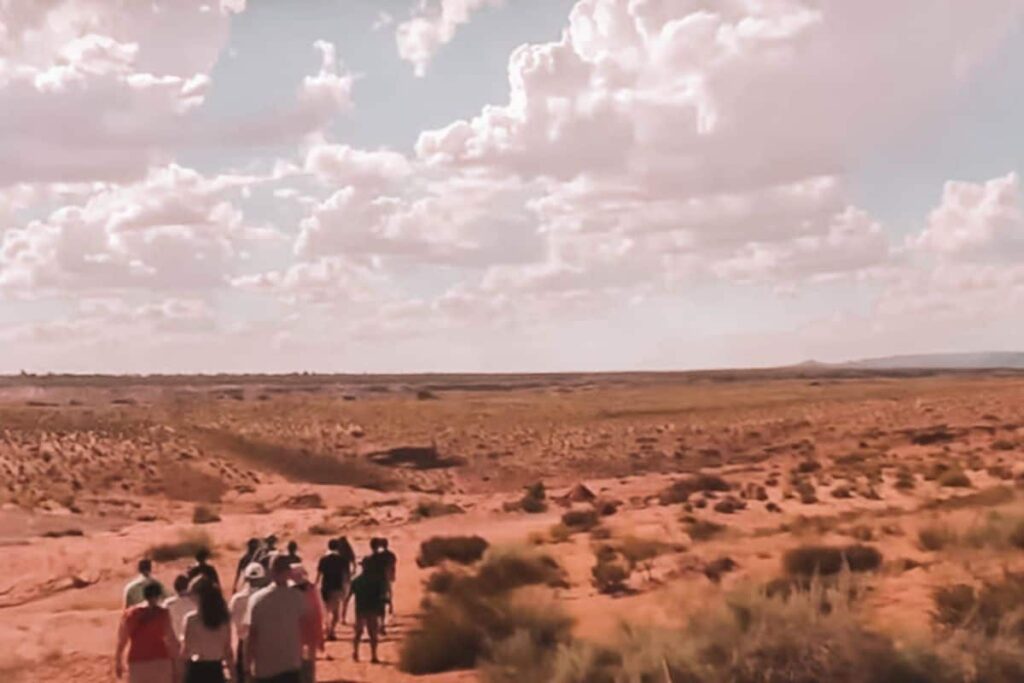
Upper Antelope vs Lower Antelope: Which is the most picturesque canyon?
If you have never seen a slot canyon before, you and your partner will be amazed by both Upper and Lower Antelope Canyon. In our opinion, both canyons are incredibly beautiful, but here’s our take on which one is the most picturesque.
Upper Antelope Canyon
Upper Antelope Canyon is absolutely stunning and has a unique charm. It’s no wonder that it attracts professional photographers and is popular for photography tours. The canyon walls are much higher than those of Lower Antelope Canyon, creating a sense of grandeur. The darker spots within the canyon add a touch of mystery and make you feel like an explorer. The light beams that occur from March to October are truly breathtaking and add a unique element to the upper canyon experience. But note that outside this period, light beams are pretty rare so it doesn’t make a difference with Lower antelope Canyon then.
Lower Antelope Canyon
Lower Antelope Canyon is also a beautiful place with incredible sandstone formations and twists. While it may not be as visually dramatic as Upper Antelope Canyon, it still offers its own unique beauty. Keep in mind that there are no dramatic light beams or sand falling in Lower Antelope Canyon.
Winner for the most picturesque canyon
Based on our experience, we would say that Upper Antelope Canyon holds the title for the most picturesque canyon. Its stunning features, including the high walls, dark spots, and mesmerizing light beams, make it an unforgettable sight. However, please remember that beauty is subjective, and both canyons have their own distinct appeal.
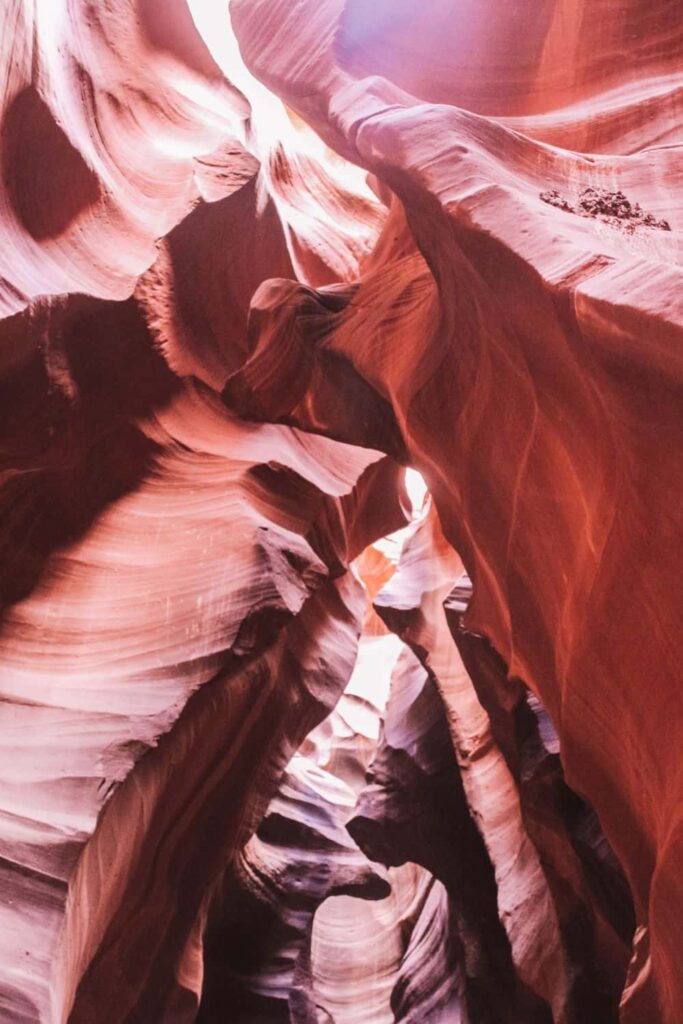
Lower or Upper Antelope Canyon: Which is best for the famous light beams?
When it comes to experiencing the famous light beams in Antelope Canyon, Upper Antelope Canyon is the place to go. The narrow ceiling of the upper canyon creates the perfect conditions for the light beams to occur. Specifically, between 10:30am and 1pm during the months of March to October, when the angle is just right, you will witness the breathtaking light beams in all their glory.
On the other hand, Lower Antelope Canyon has a larger ceiling, which means it does not offer the same opportunity to see these stunning light beams. So, if you’re looking to capture the beauty of the light beams, Upper Antelope Canyon is the best choice but only during that specific period of the year.
Note that we visited in August right after 1pm and didn’t see any light beams as such. There was light coming into the canyon and it was gorgeous though so we would recommend not to obsess over that, especially if you’re not trying to get THE shot!
Upper Antelope Canyon or Lower: Which is easier physically?
Physical difficulty is an important factor to take into account when deciding between Upper vs Lower Antelope Canyon. We are lucky enough not to have any issues when it comes to physical mobility but if you do, we share the below to help you decide what’s best suitable for you.
Upper Antelope Canyon Difficulty
To begin your journey in Upper Antelope Canyon, you’ll enjoy a comfortable 4×4 car ride, eliminating the need for any walking. Once inside the canyon, you’ll find a flat and spacious terrain with no stairs or ladders to navigate. The ground level entrance makes it easy to access and explore without the need for climbing or maneuvering.
While there are a couple of deep sandy sections, they are not long, and the rest of the sand is packed, making it easy to walk on. The round trip walk is just 0.5 miles, providing a relatively short and enjoyable stroll. It’s a fantastic opportunity to learn about canyons and their unique features without requiring significant physical effort.
Lower Antelope Canyon Difficulty
While Lower Antelope Canyon is not particularly challenging, it does require a bit more effort compared to Upper Antelope Canyon. You’ll start with a 1/4 mile walk to the canyon entrance, which is relatively flat and manageable. However, there is a set of stairs measuring 75 feet (25 meters), which can be steep and may pose a challenge for individuals with a fear of heights like myself.
Note that if you do have a fear of height, though I found it challenging, I did manage to get down the stairs and the guide was patient with me. I ended up going down at the end of the group so I didn’t feel pressured by people. Everyone was really nice about it.
Additionally, there are a few ladders along the way as you explore the 1.5-mile-long canyon. The narrower passages of Lower Antelope Canyon can create a sense of being more confined, which may affect individuals who are sensitive to tight spaces.
Winner for easiest accessible canyon
In terms of physical ease, Upper Antelope Canyon takes the crown. With no stairs to climb, a flat terrain, and no ladders or climbing involved, it offers a more straightforward and comfortable experience. The shorter round trip walk also adds to its accessibility, making it an excellent choice for those looking for a hassle-free exploration of Antelope Canyon.

Antelope Canyon Upper vs Lower: Which has smaller groups?
When it comes to the size of tour groups in Antelope Canyon, Lower Antelope Canyon tends to have smaller groups compared to Upper Antelope Canyon.
Group Sizes
Both Upper and Lower Antelope Canyon require guided tours, and it’s common to have groups with close to 40 people. Since there are usually several tours happening simultaneously, groups take turns entering the canyons. However, the one-way tour system in both canyons makes it easier to circulate within the canyon. In recent years, efforts have been made to decrease waiting times at the entrance by reducing the number of tours.
Visitor Volume
During peak season, Upper Antelope Canyon can have up to 10,000 visitors per day, leading to larger group sizes. In contrast, Lower Antelope Canyon may have smaller groups, sometimes even with only one or two people on the tour, especially during quieter periods such as January. However, it’s essential to keep in mind that group sizes can vary depending on the season and time of visit.
Our Experience
During our visit to both canyons in August, we found that our group was smaller for Lower Antelope Canyon. However, it’s worth noting that even in Upper Antelope Canyon, the group size did not feel overwhelming. It’s expected to have larger groups during peak season, and we might have been fortunate with our experience. The key is to manage expectations and understand that smaller group sizes cannot be guaranteed, particularly during busy times.
Winner for smaller groups
Overall, Lower Antelope Canyon is more likely to offer smaller group sizes, particularly during less crowded periods. However, it’s important to be prepared for the possibility of larger groups, especially when visiting during peak season. Regardless of the group size, both Upper and Lower Antelope Canyon offer awe-inspiring experiences that should be enjoyed and appreciated.
Lower vs Upper Antelope Canyon: Which is better for photo opportunities?
When it comes to capturing stunning photographs, both Lower and Upper Antelope Canyon offer unique opportunities. However, there are some distinct factors to consider.
Upper Antelope Canyon Photo Opportunities
Upper Antelope Canyon is often described as a photographer’s dream. Its picturesque beauty has graced screensavers and National Geographic features.
Although there are no specific photography tours in Upper Antelope Canyon anymore, you can still capture amazing shots. The canyon’s darker environment requires adjusting your camera settings, such as increasing ISO, as flash and tripods are not allowed. However, the advantage of the darkness is that you can brighten up your photos later during editing.
The wide base of the canyon provides ample space for capturing stunning images with fewer people in the frame. The light beams that occur during midday create a cool effect, and you can also capture shots of the cracks in the ceiling.
While you have limited time for photography (about 30min) on the way to the end of the canyon, our experience with guide Charles was fantastic. He allowed us plenty of time to take photos, helped with our camera settings, and guided us to capture the best parts of the canyon. It didn’t feel rushed and we took plenty of photos!
Lower Antelope Canyon Photo Opportunities
Lower Antelope Canyon offers a different photography experience. Although tripods are not allowed, the canyon is generally brighter compared to the upper canyon.
You don’t need to increase your ISO as much as in the upper canyon. However, due to its narrower bottom, it can be a bit more challenging to capture the desired shots. The advantage of Lower Antelope Canyon is that you have the entire 1 hour 30 minutes to photograph the canyon.
Our experience with guide Tyler was wonderful, and we never felt rushed. We had the opportunity to take photos of ourselves and everything we wanted.
Winner: The Best Canyon to Photograph
While both Lower and Upper Antelope Canyon offer remarkable photo opportunities, the upper canyon stands out for its unique formations, cool effects such as light beams and sand falls, and more spacious areas for photography. The ample time provided by the guide allows you to fully capture the beauty of the canyon. However, it’s important to note that Lower Antelope Canyon is equally stunning in photographs. The choice ultimately depends on the specific shots and effects you desire.

Upper Antelope Canyon vs Lower Antelope Canyon: Which is better for falling sand?
If you’re looking for the experience of falling sand in the canyons, Upper Antelope Canyon is the one to visit. During the months of June through August, particularly during mid-day, you may witness the mesmerizing sight of sand falling from the canyon’s walls. It creates a unique and captivating effect, adding to the beauty of the surroundings.
Antelope Canyon Upper or Lower: Which one has the ladders?
Lower Antelope Canyon is the canyon that features ladders. As you explore this canyon, you will encounter a few ladders along the way. These ladders are part of the adventure and provide access to different sections of the canyon, enhancing the overall experience.
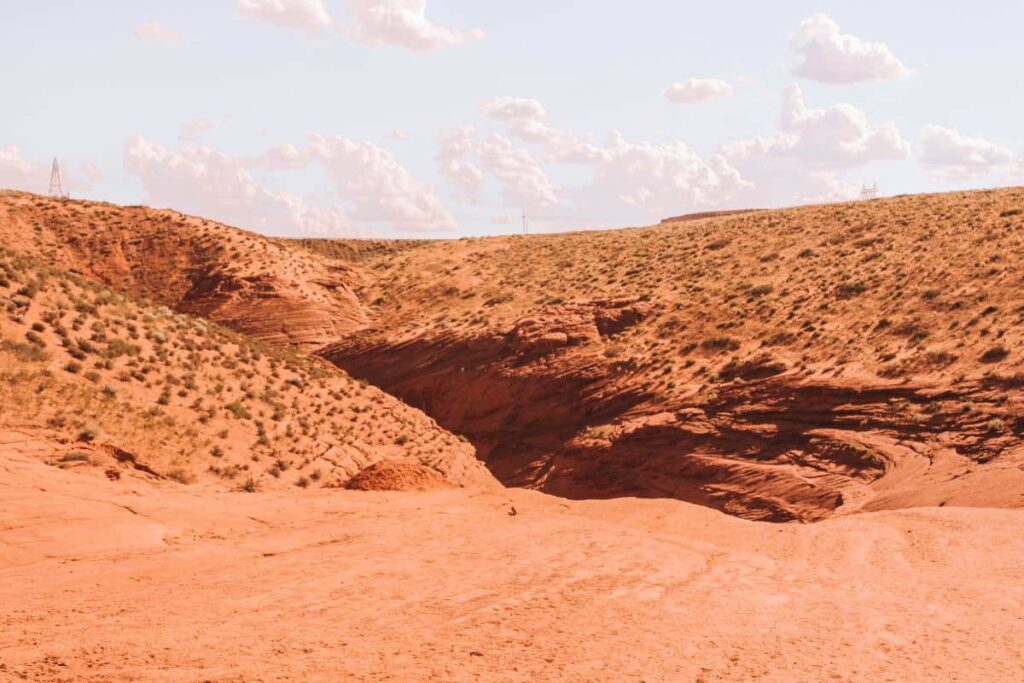
Upper vs Lower Antelope Canyon: Which is better for kayaking?
If you’re interested in kayaking through the canyons, Lower Antelope Canyon is the only option. To begin your kayaking journey, you’ll need to start from Lake Powell’s marina. We have a detailed guide to assist you in arranging a kayaking excursion to Antelope Canyon, allowing you to explore the breathtaking beauty of the canyon from a unique perspective. Exploring canyons is one of our favorite last minute date ideas in non touristy places! It’s also one of the best dates you can have in Utah and Arizona! But if you plan on kayaking to Lower Antelope canyon, we recommend booking in advance!
Lower Antelope vs Upper Antelope: Which one if you’re short on time?
Upper vs Lower Antelope Canyon for a half day?
If you find yourself short on time and have at least a half day available, we would recommend visiting Upper Antelope Canyon. It is slightly more beautiful and impressive, offering stunning formations and unique features. We suggest trying to book a tour for Upper Antelope Canyon first if you can only choose one. However, if there are no available bookings, Lower Antelope Canyon is a great alternative. It also provides a wonderful experience with slightly fewer crowds, making it equally enjoyable.
Upper vs Lower Antelope Canyon for a couple of hours?
If you only have a couple of hours to spare, Lower Antelope Canyon would be the ideal choice. The entrance is within walking distance, saving you about 30 minutes of the 4×4 ride. The tour itself lasts approximately 1 hour and 30 minutes, allowing you to explore the beauty of the canyon within a limited timeframe.
Lower Antelope Canyon vs Upper Antelope Canyon: Which is better for orange swirls?
When it comes to experiencing the mesmerizing orange swirls, Upper Antelope Canyon takes the spotlight. With its narrower passageways and the way sunlight filters through the narrow openings, Upper Antelope Canyon offers more light and a greater play of colors, resulting in stunning orange swirls. The combination of the canyon’s unique shape, sunlight, and sandstone formations creates a captivating display of vibrant hues and intricate patterns. If you’re looking to immerse yourself in the beauty of orange swirls, Upper Antelope Canyon is the ideal choice.
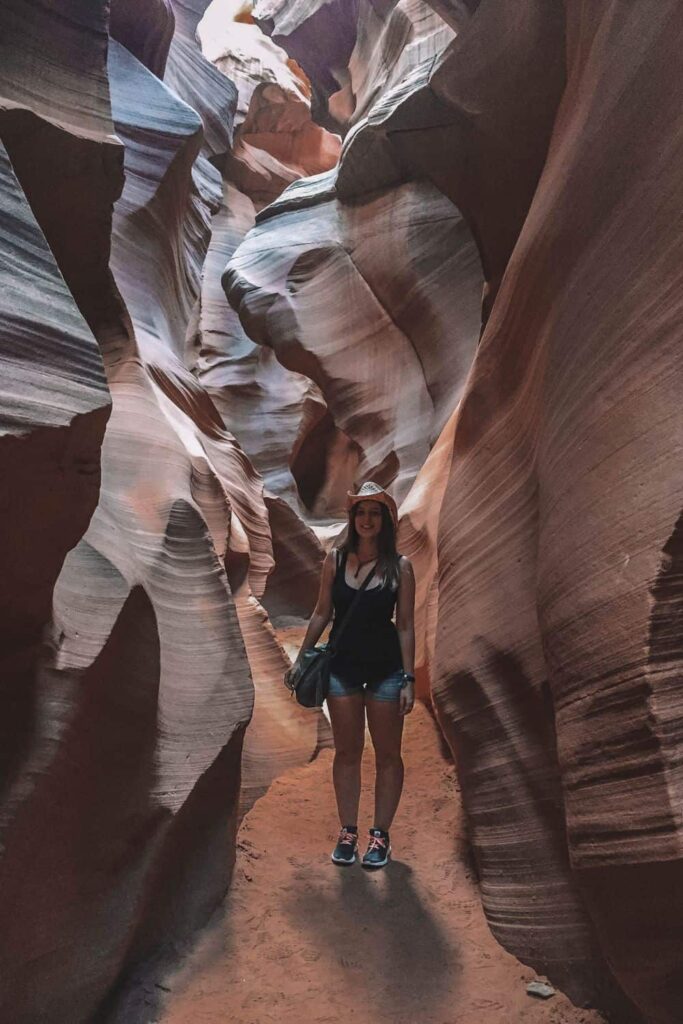
Antelope Canyon Lower or Upper cost comparison
When it comes to the cost of visiting Antelope Canyon, there have been significant changes in recent years. The prices have more than doubled, with the current rates being around $90 for Lower Antelope Canyon and $140 for Upper Antelope Canyon. Back in 2015, we paid under $50 per person plus an $8 fee, so there has been a notable increase in the cost.
For Upper Antelope Canyon, there are four tour companies offering tours, and the pricing varies depending on the prime time slots, which tend to be more expensive. On the other hand, Lower Antelope Canyon tours are operated by two companies, Ken’s Tours and Dixie Ellis, and the prices for both are roughly the same.
It’s important to note that in addition to the tour company costs, you will also need to consider additional expenses such as the Navajo Park Permit, which is $8, or taxes and fees amounting to $9.15. However, if you plan to visit both Lower and Upper Antelope Canyons on the same day, you only need to pay the Navajo Park Permit fee once, which can help you save some money.
Winner: Upper vs Lower Antelope Canyon Cost
In terms of cost, Lower Antelope Canyon is the more budget-friendly option. By combining both canyons into a single day visit and paying the Navajo Park Permit fee only once, you can further maximize your savings.
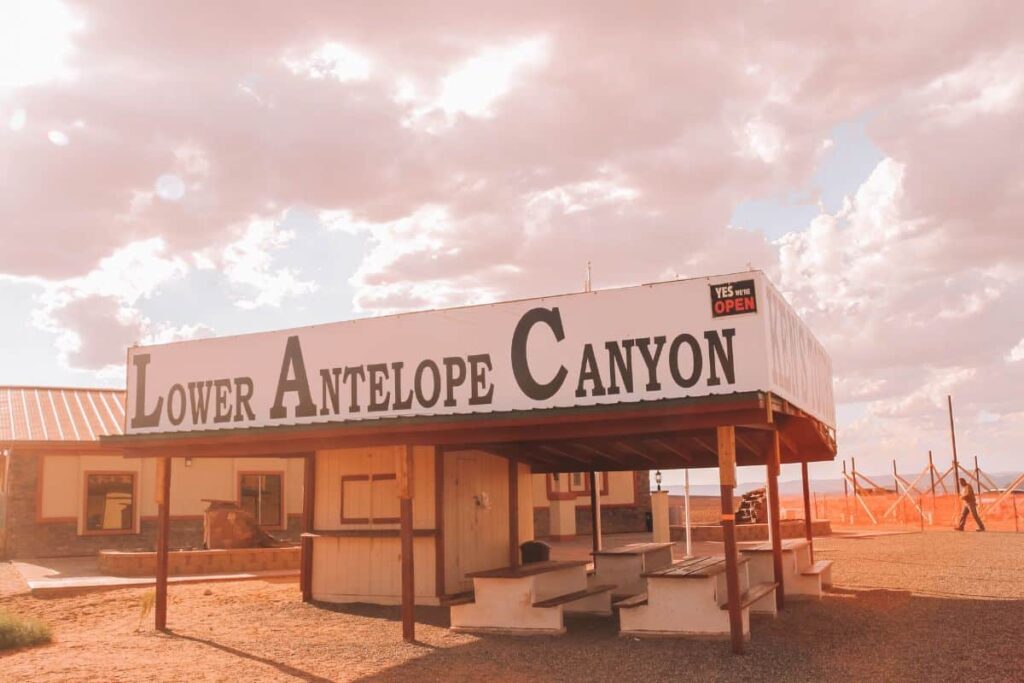
Upper and Lower Antelope Canyon Tours
Upper Antelope Canyon Tours
⭐️ RATING: 4.7 /5 Stars | ⏳ TOUR LENGTH: about 1.5 hours | ✅ Book it!
When we took the Upper Antelope Canyon tour, it lasted around an hour and a half. It’s no surprise that this is the most popular of the two canyons, and tours are available year-round. Our guide was fantastic, very knowledgeable, and took the time to show us the best settings for taking photos, especially during the peak season. The group size was decent, and the 4×4 ride to the canyon was quite enjoyable. We highly recommend this tour and had a great experience, capturing some amazing photo souvenirs.
Check availability for Upper Antelope Canyon tickets here
Best Lower Antelope Canyon Tours
⭐️ RATING: 4.7 /5 Stars | ⏳ TOUR LENGTH: about 1.5 hours | ✅ Book it!
The Lower Antelope Canyon tour lasted about 1.5 hours, and the canyon itself is longer compared to the Upper Canyon. Our guide, Tyler, was excellent and patient, especially when I got scared of the height of the stairs (hello fear of heights).
He provided us with interesting information about the canyon, showed us how to take photos and capture certain angles and unique orange twists. It’s a good idea to bring a water bottle, as the tour can be physically demanding though the guides usually bring some with them. Please note that the stairs can be steep, so if you have any mobility difficulties, it may not be the best option for you.
Check availability for Lower Antelope Canyon tickets here
Winner: Upper vs Lower Antelope Canyon Tours
We thoroughly enjoyed both the Upper and Lower Antelope Canyon tours. If you’re short on time, we recommend choosing the Lower Antelope Canyon tour, as it offers a slightly longer duration.
However, if you have the time and opportunity to visit both canyons, we encourage you to do so. If you can only pick one and have a half day available, we suggest opting for the Upper Antelope Canyon tour.
Note that there isn’t any Upper and Lower Antelope Canyon tour. You have to book each separately.
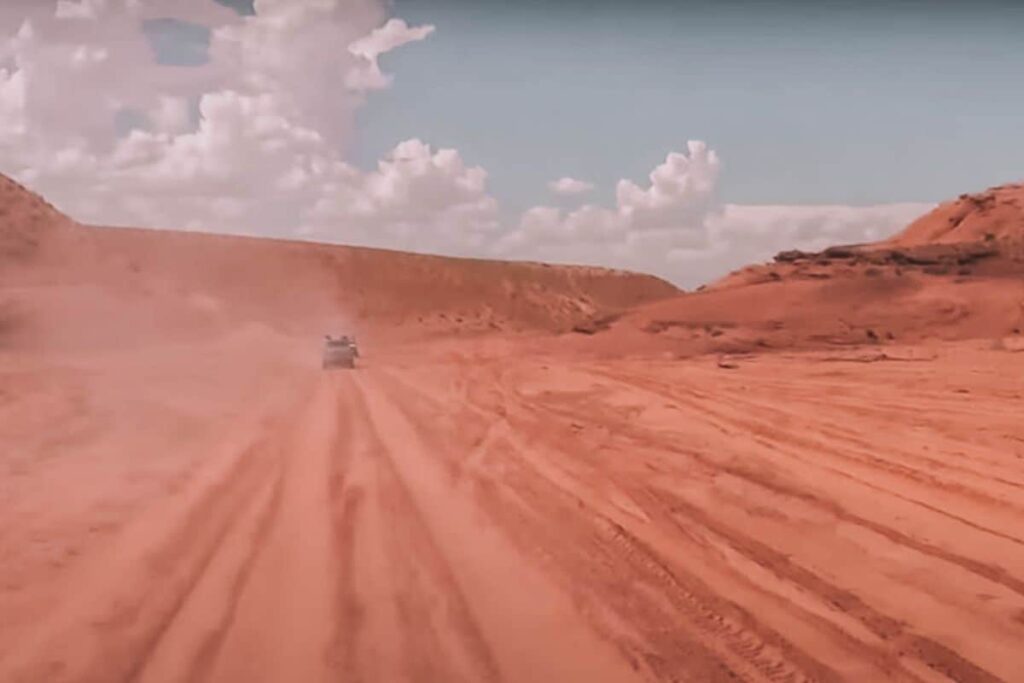
The History and Significance Of Antelope Canyon
Antelope Canyon, known as Tse’bighanilini in Navajo, holds great significance and is located on Navajo land. The Antelope Canyon Navajo name translates to “the place where water runs through rocks.” The canyon has been formed over hundreds of years as water has flowed through the Navajo Sandstone, creating narrow passageways and smooth edges through erosion caused by flash floods.
According to Navajo Nation Parks & Recreation, Antelope Canyon is considered a spiritual experience and is a sacred place to the Navajo people. It was discovered in 1931 by Sue Tsosie, who stumbled upon it while herding sheep as a young girl. Today, her daughter Carolene operates tours in the canyon.
The name “antelope” comes from the prong-horned antelope herds that used to roam the area when the canyon was discovered. It is important to respect the rules set by the Navajo and honor the sacredness of the canyon during your visit.
Photographing Upper Antelope Canyon
Photography tours are no longer allowed in Upper Antelope Canyon, but you are permitted to bring your phone or DSLR camera. Tripods are not allowed, and flash photography is also prohibited. During our tour, our guide Charles was knowledgeable and showed us the best settings on our phone to capture the beauty of the canyon. We found it easier to take photos with our phones due to the limited light in certain spots. It’s worth noting that the famous light beams can be seen in Upper Antelope Canyon from mid-March through October, between 10:30 am and 1 pm on a clear day. However, don’t get too caught up on capturing the light beams as they can be elusive. We visited during prime time and didn’t witness significant light beams, but the canyon was still incredibly beautiful even without them.
Photographing Lower Antelope Canyon
Similar to Upper Antelope Canyon, tripods are not allowed in Lower Antelope Canyon, but you are welcome to use both your phone and camera for photography. Lower Antelope Canyon tends to have more natural light, making it easier to capture stunning photos. Our guide Tyler provided us with helpful tips and settings on our phone to ensure we captured the best images of the canyon. Lower Antelope Canyon is known for its twisting passageways, offering unique photo opportunities.
Photographing Both Canyons
If you plan to photograph both Upper and Lower Antelope Canyon, we recommend bringing a wide-angle lens to capture more than just the canyon walls. Lighting conditions can be challenging, so using a slower shutter speed (between 2 and 6 seconds) can help capture the ambient light. It’s important to keep still during the exposure to avoid blurry images. Additionally, familiarize yourself with ISO settings to adjust the sensitivity of your camera to light conditions.
Remember to be respectful of the canyons and follow any guidelines provided by your guides to ensure a safe and enjoyable photography experience.
The Best Time To Visit Antelope Canyon
For best light
If you want to capture the best light in Antelope Canyon, we recommend visiting Upper Antelope Canyon around 10:30 am and Lower Antelope Canyon around 1:30 pm. These times are considered “primetime” for optimal lighting conditions and enhance the beauty of the canyon. Keep in mind that tours during these hours may be more expensive. The ideal time to visit is between March and October when the light is at its best.
For less crowds
If you prefer to explore Antelope Canyon with fewer crowds, we suggest planning your visit during the spring, fall, or winter seasons. These are considered low and shoulder seasons, and you are likely to encounter fewer tourists compared to the peak summer months.
Additionally, visiting during weekdays rather than weekends can also help you avoid larger crowds and have a more peaceful experience. We also like to show up in the morning as usually most poeple come later in the day. It’s the perfect morning adventurous date for example!
For your budget
If budget is a concern, visiting Antelope Canyon during the winter months can be a great option. From November to February, there are typically fewer visitors, resulting in lower prices. This is considered the low season, and you may be able to find discounted rates for tours during this time. It’s a fantastic opportunity to experience the canyon’s beauty while saving some money.
Antelope Canyon In The Winter
Winter is a wonderful time to visit Antelope Canyon if you prefer a quieter experience with fewer crowds. The reduced tourist numbers during the winter months allow you to explore the canyon in a more peaceful setting. Additionally, you may find that prices are lower during this time, offering a great opportunity to enjoy Antelope Canyon on a budget. The winter season in Antelope Canyon spans from November to February, making it an ideal time to discover the canyon’s stunning formations in a serene atmosphere.

Can you see Upper and Lower Antelope Canyon in the same day?
Absolutely! It is definitely possible to visit both Upper and Lower Antelope Canyon in a single day. In fact, that’s exactly what we did during our trip. We started with Upper Antelope Canyon at 2pm and then proceeded to Lower Antelope Canyon at 4pm. The two canyons are conveniently located only 7.5 miles apart, making it easy to visit both within a short span of time.
Additionally, on the same day, we had the opportunity to explore Monument Valley as well. We woke up early at 4am and ventured into Monument Valley, where we enjoyed a memorable horseback riding experience with our Navajo guide, Adel. Riding the horses for about 1 hour and 30 minutes in the stunning Monument Valley is still one of our favorite memories to date! If you’re on a road trip, we recommend playing either our truth or dare questions for couples or some of our other favorite couples road trip games here.
Afterward, it took us about a 2-hour drive to Antelope Canyon, where we continued our adventure by exploring both Upper and Lower canyons. It was a fulfilling day, packed with incredible sights and experiences. So, if you’re up for an adventure and have the time, combining a visit to both Antelope Canyon canyons and a stop at Monument Valley in the same day is definitely doable.
Alternatives Slot Canyons to Visit
If you’re looking for alternative slot canyons to explore besides Upper and Lower Antelope Canyon, here are a few options to consider:
Upper vs Lower Antelope Canyon Alternative: Antelope Canyon X
⭐️ RATING: 4.6 /5 Stars | ⏳ TOUR LENGTH: about 1.5 hours | ✅ Book it!
If you prefer a less crowded experience, Antelope Canyon X is a great choice. It is also a slot canyon that offers similar features to Lower Antelope Canyon. While it may not be as impressive as Upper Antelope Canyon, Antelope Canyon X provides opportunities to see beautiful light beams. One advantage of visiting Antelope Canyon X is that it is still relatively under the radar, which means it tends to be less crowded. Additionally, it is a more affordable option compared to the other canyons.
You can find our full guide to Antelope Canyon X here.
Check if tickets are still available here
Kayaking to Lower Antelope Canyon
If you’re seeking a unique and independent experience, you can consider kayaking to Lower Antelope Canyon from Lake Powell. This allows you to visit Lower Antelope Canyon without a guided tour, giving you the freedom to explore at your own pace.
While there won’t be a guide to provide information about the canyon, kayaking to Lower Antelope Canyon can be a fun and physically engaging activity. It is important to note that kayaking can require some physical effort, but it offers a rewarding and enjoyable way to experience the canyon.
Check out our comprehensive guide on kayaking to Lower Antelope Canyon here.
Waterhole Canyon: A More Adventurous Option
For those seeking a more adventurous slot canyon experience, Waterhole Canyon is worth considering. It is a slot canyon that offers tours to visitors. The tour typically lasts for about 1.5 hours, allowing you to explore the canyon’s unique features and natural beauty.
Waterhole Canyon is known for its adventurous nature, providing a different experience compared to Upper or Lower Antelope Canyon. Joining a guided tour in Waterhole Canyon allows you to have a structured and informative experience with experienced guides who can share their knowledge about the canyon.
How to Get to Upper and Lower Antelope Canyon
Getting to Upper and Lower Antelope Canyon is relatively easy, especially if you are in Page, Arizona. It is only a 10-15 minute drive from Page to reach the canyons. There are many Antelope Canyon tours from Page. Both Upper and Lower Antelope Canyon are located close to other popular attractions such as Horseshoe Bend, Lake Powell, and the Toadstool. If you want to push to Utah, Utah National Parks like Zion National Park or Arches National Park in the morning are amazing as well! If you’re happy to push more through Arizona, other points of interest include Saguaro National Park, Grand Canyon and Sedona!
If you are coming from Monument Valley, it will take you approximately 2 hours to reach the canyons. If you prefer to fly, there is a municipal airport in Page. Alternatively, you can fly into Bluff and then drive to the canyons, which is what we did during our Utah-Arizona road trip itinerary. The sites are easy to spot along the road, making them accessible for visitors.
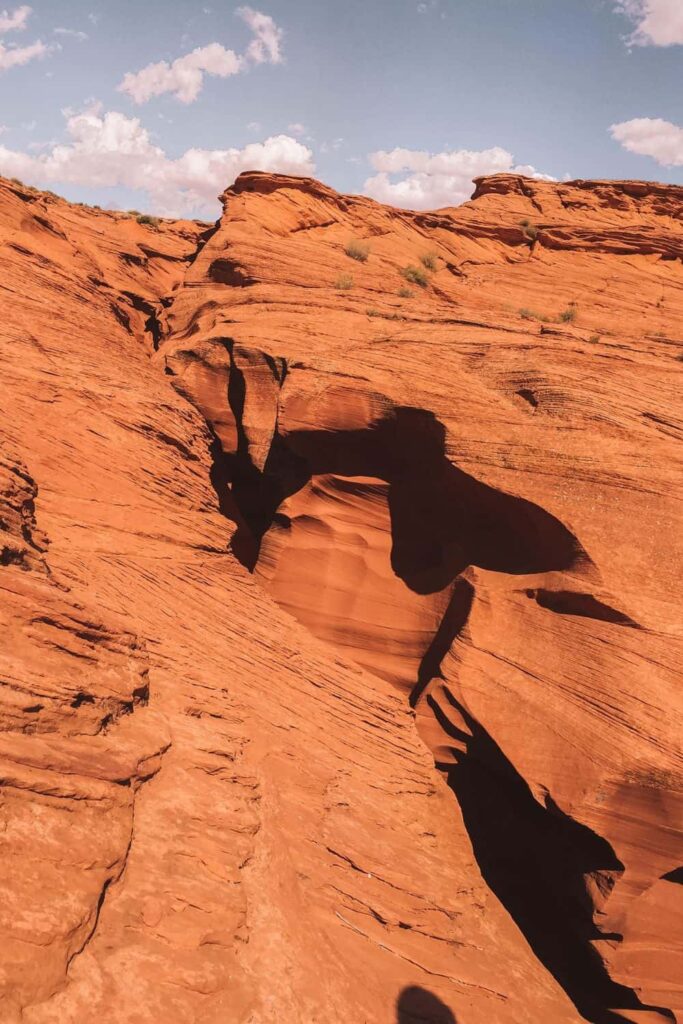
What to Bring When Visiting Upper or Lower Antelope Canyon
As you will be visiting the desert, it is important to come prepared, especially during peak season when it can get hot. Here are some essentials to bring with you:
- Hat to protect yourself from the sun
- Sunscreen to apply and reapply throughout your visit
- Sufficient water to stay hydrated, as there are no nearby stores
- Snacks or food, as there are no dining options in the immediate area
- It’s worth noting that there is a no backpack or bag policy in the canyon, so wearing pants or shorts with pockets can be convenient for carrying small items
- Consider bringing a change of clothes, as the canyons can be quite dusty, and you may prefer fresh clothing after your visit.
Is it Worth Visiting Upper Antelope Canyon at “Primetime”?
Whether it is worth visiting Upper Antelope Canyon during “primetime” depends on your preferences, particularly if you are interested in seeing the famous light beams. If the light beams are not a priority for you, then it may not matter as much.
However, if you do want to experience the light beams, visiting during “primetime” is recommended. Keep in mind that the presence of light beams is not guaranteed, especially if the weather is overcast.
It’s important to note that during “primetime,” the canyons tend to be busier with more visitors. Consider weighing the importance of the light beams against the potential crowds to decide if it is worth it for you.

Final Tips: Upper vs Lower Antelope Canyon
Both Upper and Lower Antelope Canyon can be visited year-round, providing opportunities for breathtaking experiences regardless of the season.
However, it’s important to be mindful of the weather conditions, especially during the monsoon season when flash floods can occur even if the storm is miles away.
Additionally, if you plan to visit in June, July, or August, be prepared for hot temperatures exceeding 100 degrees Fahrenheit.
Don’t forget to use our Arizona captions and Antelope Canyon captions to illustrate your photos when sharing them with your friends and family!
So, Which Canyon is Better? Upper vs Lower Antelope Canyon
While both Upper and Lower Antelope Canyon offer their own unique beauty, if we had to choose, we would say Upper Antelope Canyon is slightly better. The stunning sandstone walls, mysterious dark spots, and the possibility of witnessing mesmerizing light beams make it an exceptional experience.
However, we must emphasize that we loved both canyons, and they provide different experiences worth exploring. Therefore, we highly recommend visiting both if you have the opportunity.
If you’re seeking a unique and less crowded experience, kayaking to Lower Antelope Canyon can be a fantastic alternative. By embarking on a kayaking and hiking romantic adventure from Lake Powell, you have the opportunity to explore Lower Antelope Canyon at your own pace. While there won’t be a guide to provide in-depth information about the canyon, the freedom and tranquility of kayaking can create a memorable and personal experience.
Final thoughts: Upper vs Lower Antelope Canyon
Choosing between Upper and Lower Antelope Canyons depends on your preferences and priorities. If you prioritize stunning light beams and sand falls, Upper Antelope Canyon is the better choice. It offers more dramatic photography opportunities and a slightly more impressive overall experience.
On the other hand, Lower Antelope Canyon provides a more adventurous and physically challenging experience, with narrow passageways and steep stairs. It also tends to be less crowded and offers better lighting for photography.
If you have limited time, we recommend Upper Antelope Canyon but if you have the opportunity, visiting both canyons offers a more complete and diverse experience.
Upper vs Lower Antelope Canyon FAQs
Upper Antelope Canyon is considered more beautiful due to its abundance of light beams and sand falls, creating a breathtaking and otherworldly atmosphere.
Upper Antelope Canyon is easier to navigate as it does not have steep stairs, making it more accessible for visitors.
Upper Antelope Canyon is preferred for photography because of its famous light beams, while Lower Antelope Canyon offers better lighting conditions for capturing stunning photos.
Upper and Lower Antelope Canyon are approximately 7 miles apart from each other.
Yes, it is possible to visit both Upper and Lower Antelope Canyon in the same day, that’s what we did. We even included a trip to Monument Valley in the morning as well.
Both Upper and Lower Antelope Canyon have their unique appeal. Upper Antelope Canyon is more popular, especially for its renowned light beams, while Lower Antelope Canyon provides a different experience and is equally captivating.
Lower Antelope Canyon is considered more challenging due to its steep stairs and longer paths, requiring more physical effort.
The best time to visit Antelope Canyon is generally from March to October when the lighting conditions are at their best, offering a more visually stunning experience.
For capturing the mesmerizing light beams, midday is the ideal time to visit Antelope Canyon. If you prefer cooler weather, early morning visits are recommended.
Antelope Canyon is located on Navajo Land and is owned by the Navajo Nation.
No, the Secret Antelope Canyon, also known as Antelope Canyon X, is comparable in quality to Lower Antelope Canyon, not Upper Antelope Canyon.
The best Antelope Canyon depends on individual preferences. Upper Antelope Canyon is more popular and famous for its light beams, while Lower Antelope Canyon offers better lighting conditions and accessibility. Choose according to your desired experience.
Self-guided tours are only allowed for visitors who choose to kayak to Lower Antelope Canyon. Otherwise, guided tours are the standard way to explore both Upper and Lower Antelope Canyon.
Yes, there is a bag policy in place for Antelope Canyon. Visitors are not permitted to bring bags or backpacks into the canyon.
No, pets are not allowed on the Antelope Canyon tour.
Any questions on the comaprison Upper vs Lower Antelope Canyon? Drop them in the comments or on insta @twolostexplorers and we will get back to you asap.
— SAVE THIS POST —
Did you like this post? If you liked this post, don’t hesitate to share it!
Want to save this post? You can pin the following images on pinterest to save this post.
We are Mary and Eric, the founders of Be Right Back, a blog dedicated to romance around the globe and at home.
We are Mary and Eric, the founders of Be Right Back, a blog dedicated to romance around the globe and at home. With over 10 years of experience in dating and traveling to romantic places, we share our favorite date ideas and romantic destinations to help couples level up their relationships. Having lived in and traveled through the USA, we also share our favourite things to do in the States.
With 70,000 monthly readers and 16,000 followers on social media, Be Right Back is your go-to resource for romantic trip ideas and couple activities at home and abroad.
